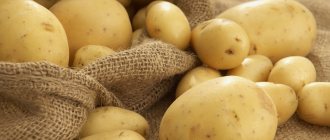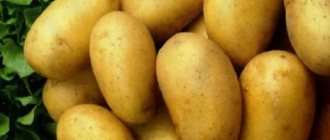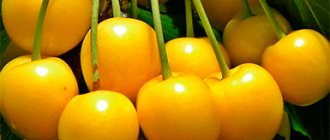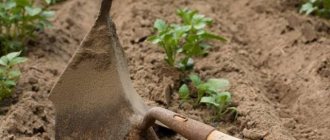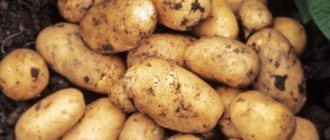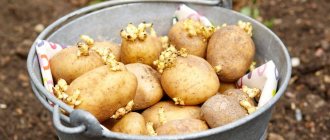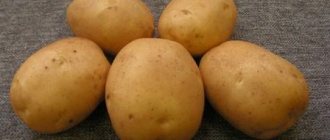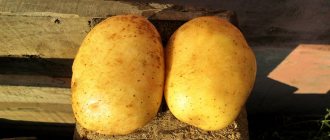Vegetable growing » Potatoes
0
1034
Article rating
Kira Stoletova
Early vegetables are always at a premium on the market, so summer residents and gardeners strive to set aside part of the land for growing early varieties. Bullfinch potatoes have gained popularity due to the fact that the first harvest can be harvested as early as June (even in regions with relatively low average annual temperatures).
Characteristics of the potato variety Bullfinch
The variety of Russian selection was included in the State Register of the Russian Federation in 2001, recommended for breeding in the center and north of the European part of Russia, Western Siberia, and the Urals. The name indicates that the crop is frost resistant.
Origin story
The bullfinch was bred at the Northwestern Scientific Research Institute of Agriculture and the Vavilov Institute of General Genetics.
It is in demand among small farms and gardeners who grow potatoes in their garden plots.
High yields were noted when grown in the North-West region.
The table presents data on the mass of marketable tubers (grams) of different varieties:
| Name | Variety | Weight |
| Nikulinsky | Late ripening | From 70 to 120 |
| Cardinal | Late ripening | 65-110 |
| Rocco | Late ripening | 100-120 |
| Picasso | Late ripening | 80-140 |
| Borovichok | Early ripening | 120-200 |
| Elmundo | Early ripening | 120 |
| Felox | Early ripening | From 100 to 120 |
| Bellarosa | Early ripening | From 120 to 210 |
| Karatop | Extra early | From 58 to 100 |
| Zhukovsky early | Extra early | 100 to 120 |
| Farmer | Extra early | From 90 to 110 |
| Minerva | Extra early | From 120 to 245 |
| Sorcerer | Mid-late | From 75 to 120 |
| Mozart | Mid-late | From 100 to 150 |
| Grenada | Mid-late | From 800 to 100 |
| Melody | Mid-late | From 95 to 180 |
| Giant | Mid-early | 100-140 |
| Tuscany | Mid-early | From 90 to 125 |
| Purple Haze | Mid-early | From 90 to 160 |
| Openwork | Mid-early | 90-120 |
Planting scheme
The variety is unpretentious in cultivation and bears fruit successfully on different types of soil. Loams, sandy soils, and transitional soil mixtures are suitable for it. An invariable condition for good yield is the application of fertilizers when plowing the field or during planting.
For 1 hectare of land they contribute:
- 40–80 kg of rotted compost or humus;
- 400 g superphosphate;
- 800 g of ash;
- 200 g of potassium sulfate.
Medium-sized tubers (weighing up to 80 g) are used for planting. Larger tubers are cut into pieces (3-6 eyes are left on each).
Planted to a depth of 10 cm in loose chernozems, deeper in sand (up to 12–14 cm). In heavy soils, potatoes are planted to a depth of 5–6 cm.
To disinfect planting material, solutions of manganese or formaldehyde are used. Fungicides (Acrobat, Sectin, Revus) protect tubers from fungal pathogens. Potatoes are soaked in a solution of insecticides (Prestige, Intavira) for 30 minutes. This will prevent the invasion of the Colorado potato beetle or potato fly.
Description of the potato variety "Bullfinch"
Roots:
- Round-oval shape;
- Pink or red smooth skin with very small eyes;
- White flesh when cut;
- Starch content 15-16%.
Escapes:
- Low bush;
- Erect stem;
- Large leaves, edges smooth or slightly wavy;
- Small corollas are red-violet.
Description
According to the characteristics of the Snegir potato variety, this is a plant of medium height. The bush is erect, intermediate type. The tops are bright green in color with a large leaf; there is no waviness of the leaf edge. Red-lilac flowers are collected in large inflorescences.
The tubers are round-oval in shape, medium in size, weighing 60-90 g, with small pink-lilac eyes. The color of the roots is red or pink. The skin is very thin. The pulp is milky white. Up to 15 tubers are formed under the bush. The starch content is slightly above average - about 16%. Cookability is average. According to gardeners, potatoes have good taste and are suitable for preparing a variety of dishes.
Peculiarities
Potatoes have gained particular popularity for their rapid ripening and good yield. Key Features:
- The first harvest of young potatoes is obtained 1.5 months after emergence. The second harvest occurs after about two months;
- The average weight of tubers is from 60 to 90 grams;
- The harvest from one bush reaches 15 tubers;
- Productivity ranges from 180 to 271 centners per hectare;
- Keeping quality - 95%.
Correct fit
To obtain a high and high-quality harvest, the following activities are carried out:
- The variety is quite demanding on soil composition. It should be as light, breathable and fertile as possible;
- Tubers must first be sorted by size, specimens of irregular and atypical shape, as well as those affected by rot and stem nematode, must be rejected;
- As a preventive measure, treat the tubers before germination with the preparations “Maxim” or “Fitosporin”;
- To increase the resistance of potatoes to nematodes, it is necessary to apply mineral fertilizers. Potassium-containing granules added while digging the soil give excellent results. In the spring, the addition of such products as “Kemira potato”, nitrophoska, universal OMU “Potato”, humatized urea, and superphosphate is required;
- For good growth, wood ash is added during planting. The drug "Bulba" refers to humatized fertilizers based on ash. It is used to powder seed tubers before planting at a ratio of 90 grams of the drug per 10 kg of tubers.
REFERENCE: To increase immunity, treat the tubers before planting with Zircon or Immunocytophyte.
Planting and growing potatoes of the Snegir variety
To ensure that the future harvest does not disappoint, you must follow certain rules of agricultural technology. The planting of the Bullfinch is traditional.
Preparing for landing
From mid-spring (April) they begin to prepare planting material. If the seeds are prepared independently, then all that remains is to germinate and process them.
Important! It is advisable to buy Snegir seed potatoes from trusted sellers in order to avoid being deceived with the variety and not purchasing infected tubers.
Before planting, they are treated against diseases for the purpose of prevention, for example:
- copper sulfate;
- Aktaroy;
- Maxim;
- Fitosporin.
Important! When using chemicals, you must strictly follow the instructions for use indicated by the manufacturer on the packaging.
Some gardeners do not spray the tubers before planting, but sprinkle them with ash.
In 3–4 weeks, seed potatoes are germinated and taken outside. The air temperature should not be lower than +11°C. Sprouting sprouts on tubers will speed up the emergence of seedlings.
Soil requirements
Light and fertile soils are the most suitable for growing Bullfinch potatoes, as well as any other variety. On heavy loams, you can’t expect a rich potato harvest.
- The soil for planting vegetables is prepared in the fall: it is dug up and fertilized with organic matter (manure, humus, peat).
- It is enough to loosen loose, light soil in the spring. If the soil is heavy, then they dig it up, but not as deep as in the fall (half a shovel's length).
- Potatoes are not grown in places where peppers or tomatoes were grown, since the plants have common diseases. Planted after cucumbers, legumes, and corn.
- Add mineral fertilizers or ash to the soil. Some gardeners pour directly into the planting hole.
Many summer residents use the drug “Bulba”, which is based on ash (100 g of product per 10 kg of seed potatoes).
Note! It is permissible to plant potatoes in the same place no earlier than the fourth year after the first planting.
Dates, scheme and rules of planting
The planting time of the Bullfinch largely depends on the climatic conditions of the region.
In the northern regions, potatoes are planted from mid-May to mid-June, and in the southern regions - in late April-early May. At the end of the first summer month, a secondary planting is carried out.
- The main thing is to wait until the earth warms up to +12°C and the night frosts pass.
- Snegir potatoes are planted according to the following scheme: row spacing is at least 45–50 cm, and the intervals between planting holes are 30 cm.
- Each tuber with a sprout (3–4 cm) is buried 10–12 cm in a separate hole.
- They dig in and level the soil using a rake.
Planting scheme
After 2–3 weeks, the potatoes will sprout.
Care
To get a good harvest, follow these rules:
- Potatoes are not watered for some time after planting. Further watering is carried out depending on the climate in the growing region, as well as weather conditions and soil conditions. The soil should be sufficiently moist at the stage of bud formation and during the flowering period;
- Feeding is carried out together with the first hilling. For this purpose, a solution based on potassium, nitrogen and phosphate fertilizers is used. Excellent results are achieved by applying nitrophoska (15-20 grams per 1 m2). When first feeding, you can use manure or bird droppings. They have a fairly strong effect and should be properly diluted with water.
IMPORTANT: To protect the plant from possible burns, these fertilizers must be infused for at least a day. Fertilizers are applied together with watering and loosening the soil.
Planting a crop on the site
For planting crops, deadlines are observed depending on the region of cultivation, the density of tubers in the bed, and the manipulation algorithm.
Landing times in different regions
The Bullfinch variety is suitable for cultivation in all regions. It produces high yields in Siberia and the Urals. The tubers are transferred to the soil when it warms up to 10°C, to a depth of 10 cm.
Potatoes are planted there at the end of May, and the harvest is harvested at the end of June or beginning of August.
In regions with a temperate climate, planting is carried out in mid-May or early June. In the southern regions, planting begins in May, the first harvest is harvested, and the second one is carried out at the end of June.
Planting Density
After forming the beds, the tubers are placed in the ground, maintaining a distance between them of 25 - 30 cm, and between rows of 50 cm.
Step-by-step algorithm for carrying out planting work
Potatoes are planted according to the following algorithm:
- In the prepared area, beds are formed and holes are dug.
- The seed material is treated with a manganese solution.
- A small amount of water is poured into the hole.
- Place drainage material.
- Each tuber is placed in its own hole to a depth of 10 cm.
- Buried with earth.
- The bed is leveled with a rake.
Diseases and pests
The Snegir potato variety has average resistance to some common diseases and pests that affect the crop. Namely to:
- The causative agent of potato cancer;
- Golden nematode;
- Alternaria;
- Fusarium;
- Verticillium;
- Common scab.
Rarely affects rhizoctonia and ring rot. Late blight affects only the tops; tubers are resistant to it.
REFERENCE: Preventive measures against the Colorado potato beetle are necessary.
Caring for the "Bullfinch" on the site
To increase potato yields, it is necessary to properly care for them. Maintain watering of the crop, apply mineral fertilizers, loosen the soil, mulch, and hill up the bushes.
Watering
The first watering begins after the first shoots appear. 3 liters of water are poured onto one bush. The water is pre-settled or rain and spring water is used. The second watering is carried out during the period of budding and flowering, and the third after the end of flowering.
Important! Tap water is not suitable for watering potatoes, as it contains chlorine, which has a detrimental effect on the development of bushes and tubers.
Fertilizer application
Potatoes are fertilized with mineral or organic fertilizers. The culture prefers complexes containing phosphorus, potassium, nitrogen, and manganese. Fertilizing is carried out using the root or foliar method. With the root method, dry or dissolved fertilizers are applied near the base of the bush. In the foliar method, dissolved fertilizers are sprayed onto the leaves of plants. Feeding is carried out every 2 weeks. The main thing is not to overdo it; excess minerals have a detrimental effect on potatoes.
Loosening and mulching beds
Loosening the soil is carried out after each watering and rain. At the same time as loosening, weeds are removed from the soil. This event provides additional oxygen supply to the roots.
See also
How to properly store potatoes in an apartment or cellar at home
Read
After emergence, potato bushes are mulched with straw. The material is evenly distributed around each bush, covering all areas of the soil. This helps retain moisture at the roots, preventing the development of weeds and the penetration of pests.
Hilling
Hilling of bushes is carried out three times a season. The first hilling is done after the sprouts reach 20 cm in height, the second 2 weeks after the first, and the third 3 weeks after the second. The bush is sprinkled with earth so that 2 - 3 pairs of leaves remain on the surface.
Protection and treatment against insects and diseases
The Snegir variety is resistant to potato blight, potato blight and many viral infections. It is not affected by late blight because their life cycles do not coincide. The bullfinch is prone to infection by nematodes. At the beginning of the growing season, plants are treated with fungicides and insecticides to prevent the development of diseases. To prevent the penetration of nematodes, the area is well fertilized.
Pests that attack potatoes include:
- Colorado beetle;
- green and black aphids;
- wireworm;
- bear
Insects feed on the leaves and roots of the plant. To combat them, bushes are treated with insecticides and traps are set for them.
Important! Growing mustard between rows of potatoes will repel pests. They cannot stand the smell of mustard.
Harvesting
Harrowing, cultivation, and harvesting using heavy agricultural machinery can damage root crops. In the future, this will affect the safety of the crop.
We invite you to familiarize yourself with potato varieties that have different ripening periods:
| Late ripening | Early ripening | Very early | Mid-late | Mid-early |
| Nikulinsky | Borovichok | Forty days | Crane | Yanka |
| Cardinal | Elmundo | Karatop | Sorcerer | Giant |
| Rocco | Felox | Riviera | Mozart | Tuscany |
| Kiwi | Bellarosa | Zhukovsky early | Grenada | Purple Haze |
| Ivan da Marya | Natasha | Farmer | Melody | Openwork |
| Picasso | Ariel | Minerva | Margarita | Santana |
| Asterix | Queen Anne | Veneta | Ramona | Desiree |
| Slav | Arosa | Kiranda | Dolphin | Lady Claire |
Reviews about the variety
Most gardeners characterize the Bullfinch variety as a wonderful early-ripening variety that has proven itself well in almost all types of soil and in all regions. Consumers value this potato because after cooking it becomes crumbly and acquires an aromatic taste; its tubers are ideal for roasting over coals or in the oven.
Potatoes of various varieties:
High taste qualities, early ripening, good preservation of the crop and resistance to diseases and pests allowed the Snegir potato variety to be included in the list of the most popular varieties for cultivation in Siberian conditions.
Reviews
Elena Vladimirovna, Voronezh, 61 years old.
I didn’t like the Bullfinch, like the Magician variety. Difficult to grow, quite capricious. And the exhaust is not that great. You water, hill, fertilize, but the harvest is so-so. Not only is there not enough of it, but the tubers are also small. So that you understand, under the same growing conditions, the tubers of the same Vector that I grow in that area are many times larger. And my yield is better. Therefore, I don’t see the point in spending so much effort if there are other varieties that give better results. And as for the taste, it is bland, nothing special.
Vladimir Kozmin, Rostov, 54 years old.
I grew several varieties of potatoes last year. I decided to select my favorites for further breeding. I didn't know the choice could be so difficult. In total, I grew 8 varieties. Potatoes are different. Most of all, I liked the taste of the Bullfinch. Moderately loose, the flesh is juicy and tasty. But at the same time I was faced with a huge drawback. In comparison with other varieties, it gave 2, and in relation to some varieties even 3 times less yield. I’m a potato lover, so I had to give it up, because the taste is tasteless, and you can’t get enough of a handful of potatoes.
Larisa, 45 years old.
I liked the variety. We grow a little, since the plot is small. The disadvantages are their small size and low yield. One of the advantages is its taste. The variety is really very tasty.


